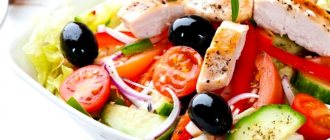Hello friends! In previous posts we have already talked a little about Greece as a country, about its population, language, features of seasonal holidays and Greek souvenirs. Today we will talk about an equally pleasant side of travel, which every tourist gets to know with particular pleasure. After a trip, many of us remember this side more often than the wonders we saw, and some even take separate tours aimed at exploring this side of the new country. Well, enough intrigue! As you probably already guessed, today we will talk about Greek cuisine and its features.
The cuisine of Greece is rightfully worthy of a separate discussion. It is an amazing combination of meat and vegetables, seafood and olive oil. Greek dishes can satisfy even the most demanding taste, and the portion sizes will not leave anyone hungry.
Catering establishments in Greece
Psarotavern “Aura” in Polychrono (Chalkidiki Peninsula)
You will be well fed in estiatorio, a cozy Greek restaurant. Fans of “bread and circuses” will find numerous taverns where, in addition to a delicious lunch, you will be invited to enjoy national songs and dances. You can learn to dance sirtaki yourself after a hearty meal. Psistarias open their doors to lovers of meat dishes, and it is better to try fish and seafood in special fish taverns (psarotaverns).
Greek dishes
First meal
Fasolada soup in a tavern on Olympus
Hot soups in this southern country are a rare occurrence. But those that exist deserve special attention. This includes a Mediterranean tomato fish soup with shrimp and a rustic bean soup (fasolada), and a gourmet rice soup with chicken broth combined with beaten eggs and lemon juice (kotosupa me avgolemono). They also praise the thick, rich beef soup (vrasto).
Meat dishes
For the main course, Greek dishes are most often prepared on the grill. Literally everything in this country has the smell of a fire – from banal meat steak and cutlets to exquisite Mediterranean king prawns. Be sure to try Greek kebabs (souvlaki), made from various types of meat, meat cutlets (bifteki), grilled lamb ribs (paidakia).
You can try Paidakia in any Greek tavern
Same as grilled meat patties
No additional side dish for meat is purchased. It is included in the price of the meat dish. Most often, baked potatoes and rice are served as a side dish.
Fish dishes and seafood
You should not ignore fish (red mullet, red mullet or swordfish) and seafood, despite the fact that they are quite expensive for a country washed by seas on all sides.
Swordfish steak
Popular in this country are squid with cheese baked over coals, breaded squid rings fried on the grill, octopus htapodi, and grilled shrimp. The signature dish in any psarotavern is spaghetti with lobster (pasta me astaco).
Grilled squid rings
Vegetables
Vegetable dishes are also traditional for Greek cuisine. The Greeks consider eggplant to be the “king of vegetables”. This vegetable is an integral part of many Greek dishes. The most popular of them is moussaka (baked eggplant in layers, minced meat stewed in tomato sauce, and the most delicate creamy béchamel sauce).
Moussaka is the most delicious thing you've ever tasted in Greece.
In addition, it is worth trying keftedes (vegetable cutlets made from mushrooms, zucchini, eggplant, tomato and peas), fried eggplants (florinis psites), baked eggplants with tomatoes and cheese (melizana psiti). Dolmates (rice balls with various seasonings in grape leaves) are also very tasty.
Dolmades is somewhat reminiscent of our cabbage rolls, only without meat
In Greece, a raw food diet is very popular: a large number of vegetables are served raw or as side dishes for meat, fish and seafood.
Sauces, pastas, light snacks
Tzatziki sauce is an essential part of a Greek lunch.
The Greeks will certainly offer all sorts of pastas, sauces and light snacks for main courses. Very popular sauce is tzatziki (natural yogurt mixed with fresh cucumber and seasoned with garlic and mint), taramosalata (caviar paste with breadcrumbs), gigantes (bean puree cooked in tomato sauce), melitzanosalata (caviar from the pulp of baked eggplants), etc. .
Melizanosalata turned out to be very tasty. First we tried it, and then we remembered that we needed to take a photo 
Salads
In the summer, when Greece languishes under the scorching heat, you want something light. Fresh vegetable salads will come to the rescue. They are very light and filling. Be sure to try Khoriatiki, known in Russia as Greek salad. The Greeks know the secret set of spices for this salad!
Traditional “Village” salad (choriatiki)
Interesting fact! Greek salad "Village" (choriatiki) in Russia is called Greek salad. How did Greece respond? In some Greek supermarkets you can find so-called Russian salad on the shelves. In taste and composition, it resembles the familiar Olivier salad. True, the Greeks really don’t like complex dishes, so some of the most complex ingredients are not put there.
In supermarkets they sell salads in jars like these. On the counter you can find tzatziki, melitzanosalata (it’s in the photo) and the well-known Russian salad
In addition to horiatika, angurodomata (a salad of tomatoes, cucumbers with the addition of onions), cabbage lajano (often with carrots, celery and sweet peppers) and marula (lettuce salad) are also popular. Separately, I would like to mention the Cretan salad “dakos”. It is prepared on large round bread crumbs with the addition of soft cheese and fresh tomatoes. Salads are dressed mainly with olive oil and lemon juice.
Traditional Cretan salad Dakos
Greek cuisine is also not complete without traditional Greek olives and feta cheese. These ingredients are the basis of many Greek dishes.
A very unusual combination is feta cheese baked with vegetables.
When placing an order in any Greek tavern, it is worth remembering that the portions here are very large and filling. A salad plate is enough to feed 2-3 adults. However, it is better to take the main dishes in half portions.
All these plates (except the salad) were brought to us when we ordered 1 portion of cold cuts for two!
Dessert
Only a sweet and tasty dessert can complement a hearty lunch. In many Greek taverns, if the owner of the establishment likes you, you will be offered dessert as a gift. Moreover, there is no way to refuse such a gift. This will show disrespect to the receiving party. So, even if you no longer have the strength to eat, swallow dessert smiling - you simply must!
Dessert “Chocolate Heart” and traditional Thessalonian triangular cream puff
What can they offer for dessert? The most famous Greek dessert is loukoumades (yeast balls sprinkled with powdered sugar or drizzled with honey). The Greeks borrowed recipes for making halva, baklava and Turkish delight from Turkish cuisine. Galaktoboureko also came from there. It resembles a grainy pudding in puff pastry. Rizogalo is also popular in Greece - a rice dish with the addition of cinnamon, nuts and dried fruits. Kourabiedes (shortbread cookies with almond pieces) and vasilopita (sponge cake with nuts and dried fruits) often appear on holiday tables in Greek families.
Ice cream with chocolate chips and chocolate brownie
In addition to pastries, I highly recommend trying traditional Greek ice cream, as well as the freshest fruit. Large cherries and strawberries are especially tasty.
A plate of cherries, a glass of wine and views of the Aegean Sea... Heaven on earth exists!
Popular Greek dishes
Greece is a country by the sea, which means seafood is present in abundance in its cuisine.
Greek salad (called "country salad" locally, "HorIAtiki"), a mixture of tomatoes, cucumbers, feta cheese and onions - chopped and mixed with olives, and sometimes green peppers or other vegetables, usually garnished with oregano. Traditionally it is seasoned only with olive oil;
Moussaka, a rich baked dish of eggplant, minced meat, tomato and white sauce
Pastitsio, a type of lasagne
Spetzofai, sausage stew with peppers and tomatoes
Saganaki, fried semi-hard cheese
Payakia, fried lamb chops, is also popular. They tend to have a stronger flavor and tougher texture than North American lamb chops.
Pies are also very popular dishes in Greece, especially filled pies such as papakopita (spinach pie), tiropita (cheese pie) and kreopotita (meat pie).
Greek drinks
And finally, a few words about Greek drinks. I have already mentioned them a little in this post, today I will add to the story. Drinks are required with every meal. A jug of water on the table in Greece is as traditional as a salt shaker in Russian canteens. Water is served with all dishes absolutely free.
Alcoholic drinks
In addition to water, I highly recommend trying local wines. The Greeks have been producing wine since ancient times. In ancient times, wine, along with water, was used to quench thirst; it was not without reason that a “special” god, Dionysus, was responsible for the production of wines. Red, white and rose wines are popular in Greece. In addition, each locality boasts its own special taste. Thus, the island of Euboea is famous for retsina (this wine is white, with an aftertaste of pine resin).
A very popular white wine in Greece
Of the strong alcoholic Greek drinks, the most popular is ouzo - vodka made from grapes and anise. When diluted with water it becomes white like milk. It is believed that the best ouzo is made on the island of Lesbos; the quality of ouzo from the island of Naxos is not inferior. Metaxa is also very popular in Greece.
Traditional vodka ouzo goes best with Greek seafood
The Greek island of Crete will offer you tsipouro as the main alcoholic drink. But be careful, the drink is very strong.
History of the Greek dish: preparing Pontic “tanomenon shirvan”
Olga Lazaridi*
Every Pontic family must prepare this fermented milk soup. It is called tanomenon shirvan. “Shirvan” among the peoples of the Turkic language group is soup. But if you hear the name tanomenon fain, it will mean the same thing. Only in Greek. During the period of Ottoman rule, many Turkic terms “migrated” to the Greek language. The reverse process was also quite common.
We agree with the opinion that this soup is not only the most traditional and very accessible dish for all social strata among the Pontic Greeks, but also a medicine for those who refuse to eat due to illness. Its fermented milk base allows for good absorption, the composition provides a sufficient amount of calories to give strength to the body, and the dressing adds a flavor that helps increase appetite.
Let's start with the fermented milk base. Today, housewives use expressed xigalan (yogurt) or iliston. But earlier the basis of the soup was pashkitan. Hence the “tan” component is present in the name of the dish. But pashkitan is not strained yogurt.
Iliston with egg (photo: Maria Lazaridi)
Any Pontic family, regardless of general income, had a cow on their farm. This includes milk, sour cream, cheese, yogurt, and butter. So, when it was time for active milking, and there was a lot of milk, housewives prepared butter. After collecting the cream, it was whipped. The white liquid - tan, which remained after the oil was taken out, was not poured out or fed to livestock. Boiled skim milk was fermented in a large container. The resulting fat-free xigalan was thoroughly mixed, put on fire and heated until it began to curdle. Tan was poured there. After the time had passed, when the mass had cooled, it was placed in a linen bag and strained. Moreover, this bag was placed under pressure for several days so that as little liquid remained as possible, because this mixture had to be stored for a long time.
This is pashkitan, which was previously mainly used.
To increase the shelf life, since a fairly large amount of pashkitan was collected, salt was added to it. It was necessary to mix everything thoroughly and put it in a clay container for storage so that there were no cavities. The air that remained during laying led to oxidation, mold formation and, as a result, everything could be given to livestock feed. If everything was done correctly, then each housewife placed in a cool place a large amount of white, maximally dehydrated product, ready for preparing her favorite dinner.
Sauteed onions with thyme in melted butter (photo: Maria Lazaridi)
Now let's focus on the cereal, which is the main part of tanomenon shirvan. Modern Pontic women prepare Shirvan using corn or rice. In our opinion, this is a more modern option and a simple underestimation of the culinary wisdom of the Pontians. It’s no secret that one of the healthiest grains for humans is wheat grain – “prugula” or its special variety – pearl barley “korkota” (groats). In addition, compared to corn and rice, they are the most budget-friendly. On the territory of Pontus, of course, corn was grown, and it was used in the preparation of other Pontic dishes, such as havits, hashil, quindean fain and others. Large parts of grains after crushing corn could be used for shirvan.
But almost no rice was grown on Pontus; they could only buy it.
It seems that it was not cheap, and many families could not afford it. Therefore, even a dish with the telling name “pilafi” was prepared from pruguli. But this does not mean a deterioration in the taste of the dish, rather the opposite. Tanomenon Shirvan, thanks to pearl barley, acquires an unforgettable taste and a unique creamy consistency.
Seasonings add their uniqueness to any dish. Tanomenon Shirvan is no exception. Dried herbs are added to the roast, which has essential oils and the smell of mint, pepper, and cardamom combined. It is collected, dried, separated from the rough stems, preserving only the inflorescences and small leaves. The herb was called “anuh” or “anugya”. This is thyme. Marjoram will add a similar aroma to the dish.
The ancient Greeks believed that marjoram gave courage and brought joy.
Herbalists of different nations mention the tonic, antiseptic properties of this plant. Very close in properties to marjoram is oregano, which is a close and related plant. It is worth noting that, of course, the place where any grass is collected is of great importance. The further north you go, the weaker the aroma.
There is an opinion that the best aroma for traditional shirvan is marjoram from Asia Minor. Pontians living in Greece use rigani (regan) - dried leaves and flowers of the Mediterranean marjoram.
The closest analogue of rigani is oregano (oregano).
It tastes more like regan than plain marjoram. Well, today every Pontic family is accustomed to the bouquet of aromas that the seasoning used gives the dish. In the absence of these dried herbs, dried mint leaves can be used. It is more accessible, but one can say for sure that it is not able to add the final chord to the taste of real Shirvan.
Shirvan before the “marriage” (photo: Maria Lazaridi)
When starting to prepare the soup, you need to cook the cereal in water until it softens well. Separately, place several spoons of thick pashkitan in a bowl. Adding water, stirring until the mixture reaches the consistency of liquid sour cream, ensuring that there are no lumps left. Next, continuing to stir, beat in the egg. Finely chopped pair of medium onions are fried in a frying pan in melted butter. Dry seasoning is added there and fried a little along with the onions.
This opens up the seasoning.
The herb will not release any flavor if thrown directly into the soup. Then everything is done at intervals of 2-3 minutes. A mixture of pashkitan and egg is moved into the container where the cereal is cooked, followed by frying, which by this time already fills the entire room with aroma. After another minute, you can turn off the heat and close the pan with a lid. When the Shirvan rests, it will thicken a little and everything inside will “get married.”
Of course, it is almost impossible to get pashkitan now, so strained yogurt (xigalan, manzyran) - iliston - is used. You can ferment boiled milk, place it in a linen bag, strain the liquid and do everything in the same way as with pashkitan.
The tastes will be close.
Let's try to prepare tanomenon shirvan and treat our loved ones with a traditional Poti Greek soup. Your mood will improve, your internal state will be balanced and your health will improve.
May everyone be healthy!!!
*Author: Olga Lazaridi (Greek language teacher-methodologist of the highest category, researcher of the culture of the Pontic Greeks)











